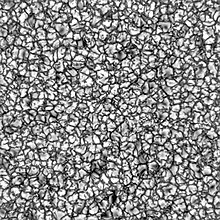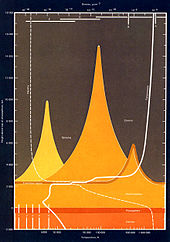
A corona is the outermost layer of a star's atmosphere. It is a hot but relatively dim region of plasma populated by intermittent coronal structures known as solar prominences or filaments.
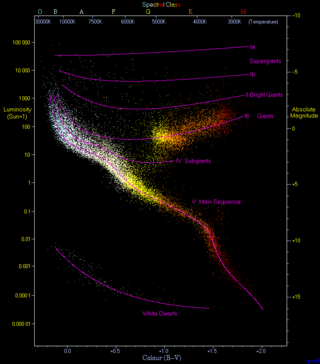
In astronomy, the main sequence is a classification of stars which appear on plots of stellar color versus brightness as a continuous and distinctive band. Stars on this band are known as main-sequence stars or dwarf stars, and positions of stars on and off the band are believed to indicate their physical properties, as well as their progress through several types of star life-cycles. These are the most numerous true stars in the universe and include the Sun. Color-magnitude plots are known as Hertzsprung–Russell diagrams after Ejnar Hertzsprung and Henry Norris Russell.

A neutron star is the collapsed core of a massive supergiant star, which had a total mass of between 10 and 25 solar masses (M☉), possibly more if the star was especially metal-rich. Except for black holes, neutron stars are the smallest and densest known class of stellar objects. Neutron stars have a radius on the order of 10 kilometers (6 mi) and a mass of about 1.4 M☉. They result from the supernova explosion of a massive star, combined with gravitational collapse, that compresses the core past white dwarf star density to that of atomic nuclei.

The Sun is the star at the center of the Solar System. It is a massive, hot ball of plasma, inflated and heated by energy produced by nuclear fusion reactions at its core. Part of this energy is emitted from its surface as light, ultraviolet, and infrared radiation, providing most of the energy for life on Earth. The Sun has been an object of veneration in many cultures. It has been a central subject for astronomical research since antiquity.

A star is a luminous spheroid of plasma held together by self-gravity. The nearest star to Earth is the Sun. Many other stars are visible to the naked eye at night; their immense distances from Earth make them appear as fixed points of light. The most prominent stars have been categorised into constellations and asterisms, and many of the brightest stars have proper names. Astronomers have assembled star catalogues that identify the known stars and provide standardized stellar designations. The observable universe contains an estimated 1022 to 1024 stars. Only about 4,000 of these stars are visible to the naked eye—all within the Milky Way galaxy.

Sunspots are temporary spots on the Sun's surface that are darker than the surrounding area. They are regions of reduced surface temperature caused by concentrations of magnetic flux that inhibit convection. Sunspots appear within active regions, usually in pairs of opposite magnetic polarity. Their number varies according to the approximately 11-year solar cycle.

A chromosphere is the second layer of a star's atmosphere, located above the photosphere and below the solar transition region and corona. The term usually refers to the Sun's chromosphere, but not exclusively.
Starspots are stellar phenomena, so-named by analogy with sunspots. Spots as small as sunspots have not been detected on other stars, as they would cause undetectably small fluctuations in brightness. The commonly observed starspots are in general much larger than those on the Sun: up to about 30% of the stellar surface may be covered, corresponding to starspots 100 times larger than those on the Sun.
HD 169830 is a star in the southern constellation of Sagittarius. It has a yellow-white hue and is dimly visible to the naked eye with an apparent visual magnitude of +5.90. The star is located at a distance of 120 light years from the Sun based on parallax. It is drifting closer with a radial velocity of −17.3 km/s, and is predicted to come as close as 20.7 ly (6.4 pc) in 2.08 million years. HD 169830 is known to be orbited by two large Jupiter-like exoplanets.
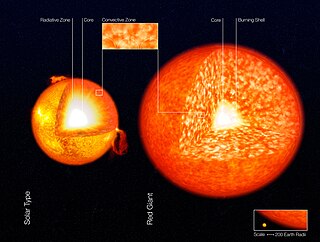
A convection zone, convective zone or convective region of a star is a layer which is unstable due to convection. Energy is primarily or partially transported by convection in such a region. In a radiation zone, energy is transported by radiation and conduction.
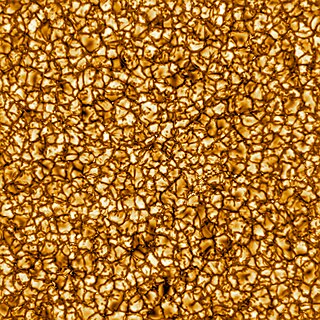
In solar physics and observation, granules are convection cells in the Sun's photosphere. They are caused by currents of plasma in the Sun's convective zone, directly below the photosphere. The grainy appearance of the photosphere is produced by the tops of these convective cells, and this pattern is referred to as granulation.
HD 114386 is a star with a pair of orbiting exoplanets in the southern constellation of Centaurus. It has an apparent visual magnitude of 8.73, which means it cannot be viewed with the naked eye but can be seen with a telescope or good binoculars. Based on parallax measurements, the system is located at a distance of 91 light years from the Sun. It is receding with a radial velocity of 33.4 km/s. The star shows a high proper motion, traversing the celestial sphere at an angular rate of 0.318 arcsec yr−1.

59 Aurigae, often abbreviated as 59 Aur, is a star in the constellation Auriga. Its baseline apparent magnitude is 6.1, meaning it can just barely be seen with the naked eye as a dim, yellow-white hued star. Based on parallax measurements, it is located about 483 light-years away from the Sun.

ι Persei, Latinized as Iota Persei, is a single star in the northern constellation Perseus. This object is visible to the naked eye as a faint, yellow-white hued point of light with an apparent visual magnitude of 4.1. It is located 34 light years from the Sun based on parallax, and is drifting further away with a radial velocity of +49 km/s. Iota Persei has a relatively high proper motion across the sky.
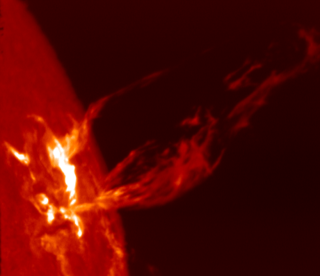
A stellar magnetic field is a magnetic field generated by the motion of conductive plasma inside a star. This motion is created through convection, which is a form of energy transport involving the physical movement of material. A localized magnetic field exerts a force on the plasma, effectively increasing the pressure without a comparable gain in density. As a result, the magnetized region rises relative to the remainder of the plasma, until it reaches the star's photosphere. This creates starspots on the surface, and the related phenomenon of coronal loops.
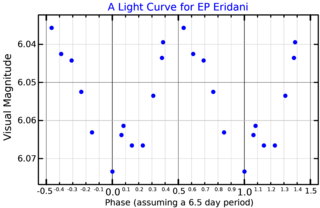
HD 17925 is a variable star in the equatorial constellation of Eridanus. It has the Gould designation 32 G. Eridani and the variable star designation EP Eri. The star has a yellow-orange hue and is dimly visible to the naked eye in good seeing conditions with an apparent visual magnitude that varies from 6.03 down to 6.08. It is located nearby at a distance of 34 light years from the Sun based on parallax, and is drifting further away with a radial velocity of +18 km/s. It is a likely member of the Local Association of nearby, co-moving stars. The spectrum shows a strong abundance of lithium, indicating that it is young star. This likely makes its point of origin the nearby Scorpio–Centaurus Complex.
In solar physics and observation, an active region is a temporary feature in the Sun's atmosphere characterized by a strong and complex magnetic field. They are often associated with sunspots and are commonly the source of violent eruptions such as coronal mass ejections and solar flares. The number and location of active regions on the solar disk at any given time is dependent on the solar cycle.

A red giant is a luminous giant star of low or intermediate mass in a late phase of stellar evolution. The outer atmosphere is inflated and tenuous, making the radius large and the surface temperature around 5,000 K or lower. The appearance of the red giant is from yellow-white to reddish-orange, including the spectral types K and M, sometimes G, but also class S stars and most carbon stars.

Solar phenomena are natural phenomena which occur within the atmosphere of the Sun. They take many forms, including solar wind, radio wave flux, solar flares, coronal mass ejections, coronal heating and sunspots.

XX Trianguli, abbreviated XX Tri, is a variable star in the northern constellation of Triangulum, about 1.5° to the WNW of Beta Trianguli along the constellation border with Andromeda. It is classified as a RS Canum Venaticorum variable and ranges in brightness from magnitude 8.1 down to 8.7, which is too faint to be visible to the naked eye. The system is located at a distance of approximately 642 light years from the Sun based on parallax, but is drifting closer with a radial velocity of −26 km/s.

